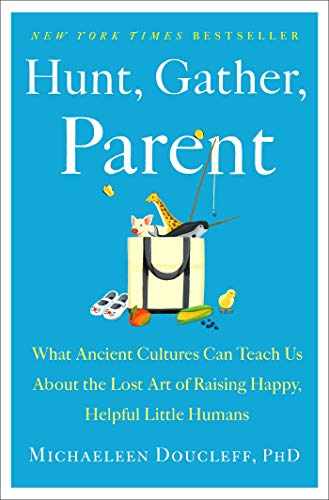KEY POINTS
- U.S. parents can learn helpful parenting techniques from non-western cultures.
- Traditional cultures interfere less in the lives of their children but provide more modeling and support.
- Why do U.S. parents expect emotion regulation of their children—but feel free to speak to them angrily?
(Listen to the book review by Darcia Narvaez and Mary Tarsha on Kindred here.)
What other cultures know about raising a helpful child
Peoples in western, educated, industrialized, rich and democratic nations (WEIRD populations) differ from most of the world in a host of ways, including parenting culture. Yet WEIRD societies are where psychologists and researchers typically live, where they typically conduct and publish research, although they generalize their findings to the rest of humanity.
In a new book, NPR reporter Michaeleen Doucleff, tries to do the opposite. Frustrated with her own experiences as a parent of a toddler, she travels to four different cultures around the world to investigate how they raise cooperative children. The result is a memoir-like guidebook for parents, Hunt, Gather, Parent: What Ancient Cultures Can Teach Us about the Lost Art of Raising Happy, Helpful Little Humans. (Listen to the book review by Darcia Narvaez and Mary Tarsha on Kindred here.)
The overall messages are about letting go of several of the controlling ways American parents use towards their children and instead take up tried and true ancient ways of raising cooperative children. The WEIRD ways of parenting actually make children more anxious and less helpful.
Externalizing Parenting
Doucleff admits that at the beginning of her learning journey, she was trying to control her toddler in a manner she had learned from her family— commanding, ordering, screaming. She would get upset when her daughter wouldn’t obey her, taking it personally. We can call this “externalizing parenting.” She became upset by her child’s behavior but blamed her daughter for making her upset. Then her own dysregulation led to dysregulation in her daughter. Things would only escalate after that.
When her pediatrician gave her a chart of advice for her six-month-old child that including feeding schedules and sleep training, she wondered where such advice originated. She discovered that such systems of control were created in foundling hospitals, where managing hundreds of babies had to be accomplished by only a handful of staff. Rigid treatment was instituted for the benefit of the adults, not the children. This made her wonder about what parents around the world do.
Here are a few of her discoveries she puts into an acronym, TEAM: togetherness, encouragement, autonomy, minimal interference. She gives lots of tips to parents along the way.
Togetherness
She learned about togetherness from a Mayan community in Mexico. The desire is for everyone to learn to be “acomedido”—attentive to what needs to be done and doing it. She learned that the Mayan and other Indigenous peoples react to a toddler’s grabbiness as a signal of initiative, a desire to contribute to the family, something to patiently allow instead of punish.
Young children are considered humans-in the-making, still with much to learn, and need older family members to model behaviors that they will learn little by little, with lots of practice, starting with small tasks at which they can succeed. They are welcomed into the middle of the family’s life activities.
The key to a cooperative helpful child and teen is encouraging them to contribute to the family. They want to feel like their contributions matter. They are part of the “we.”
This is a powerful motivation that American parents often undermine by leaving children out of the regular tasks of living (e.g., cooking, laundry) and focusing on entertaining their children. Doucleff learned to step away from being focused on what her child wants and instead focus on what needs to be done for the family, letting the child help out, however clumsily at first. She urges parents to follow what parents have done through history: maximize exposure to adult world tasks and minimize child-centered activities.
She states “togetherness is a circle of love that surrounds the child, no matter where they go,” something more easily provided in a collectivist community where the community raises the children together (p. 101).
Self-Regulate Yourself and Don’t Expect Emotion Regulation from Young Children
In Kugaaruk, an Inuit community, she learns about parental self-control. For the Inuit, she tells us, yelling at a young child or speaking angrily to a child is demeaning—the adult is stooping to the level of the child, in effect throwing a grownup tantrum. Yelling at children teaches them to not listen. Even timeouts teach children to run away.
Western parents, she says, interpret young children’s behavior as manipulation of the parents. This is a cultural myth that Doucleff suggests is used to help parents navigate behavior they don’t understand. Americans overestimate children’s emotional abilities (and underestimate their cognitive abilities). Inuit parents do not, and they consider it their responsibility to educate the child.
In contrast, the Inuit think of children as illogical, “newbie citizens trying to figure out the proper behavior” (p. 153). They expect children to be rude, violent and bossy, to make messes and do tasks poorly. “If a little child doesn’t listen, it’s because she is too young to understand. She is not ready for the lesson” (p. 155). Inuit adults expect children to display easy anger(urulu, qiquq, ningaq) and crying (huqu), because children do yet have ihuma (mind, thought, reason, understanding).
Unlike in the U.S., where children spend a great deal of time with a parent, Inuit children spend time with lots of different people. Observing the amount of time Doucleff and her daughter spent together, an Inuit community member told her: “Your daughter must be sick of you. That is why she is misbehaving’ (p. 138).
Doucleff was amazed by the maturity of the Inuit (non-toddler) children:
“In Kugaaruk, the children are dripping with executive function: They can see another child’s point of view, remain flexible when situations change, and adapt to the needs of others. They exhibit way more emotional maturity than many children older than them in the U.S.—in many ways they are more emotionally mature than me. Even the little children often act patiently, empathetically, and generously. And they’re excellent at sharing—toys, food, clothes, you name it. Objects seem to present as an opportunity to cooperate and play together instead of argue and compete.” (p. 140)
Encourage, Never Force
She learned that when a child misbehaves, it’s an indicator that they need more calmness from the parent or nature. The Inuit instead teach the out-of-control child to shift moods towards awe—by taking them outside, for example. They also need more touch. Gentle stroking releases oxytocin. Twirling the child in arms will shift their mood. “Touch lights up a child’s brain like fireworks” (p. 174). Roughhousing release BDNF, a nerve growth hormonein the brain.
Provide Autonomy
From the Hadzabe in Tanzania, she learned about reciprocity and the importance of child autonomy. Children are given control over their own lives. Children often figure out what to do if given the time and space. Parents stay quiet and out of the way; watching from a distance, intervening only if there is real danger. Hadzabe children are not helicoptered but welcomed into the community as growing members. By age six, children are capable baby caregivers. Teenagers help the younger children.
So they learn autonomy with community purpose. See here for a short video from the National Science Foundation and Barbara Rogoff’s decades-long work showing the kinds of things that Doucleff learned. It shows how non-WEIRD community members in the U.S. also learn with a community purpose.
Minimize Interference: Guide Behavior Indirectly
• Parent through action, not words. You are the role model.
• Master the art of ignoring (instead of giving attention).
• Pose questions: Who made this mess? What are you doing to your friend? Who’s being mean?
• Use responsibilities as rewards.
• Discipline without words: Turn away; “let’s be silent for one minute.”
• Use dos and don’ts sparingly.
• Use stories and drama as teaching devices.




